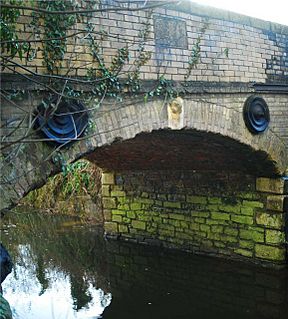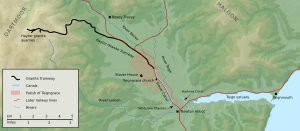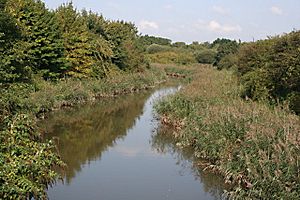Stover Canal facts for kids
Quick facts for kids Stover Canal |
|
|---|---|

The north side of the bridge at Teignbridge
|
|
| Specifications | |
| Maximum boat length | 56 ft 0 in (17.07 m) |
| Locks | 5 |
| Status | Restoration pending |
| History | |
| Original owner | James Templer |
| Principal engineer | Thomas Gray |
| Date of first use | 1792 |
| Date closed | 1937 |
| Geography | |
| Start point | Jetty Marsh, Newton Abbot |
| End point | Ventiford |
| Connects to | River Teign |
The Stover Canal is a historic waterway located in Devon, England. It first opened in 1792. For many years, it played a big role in transporting a special type of clay called ball clay. This canal helped move the clay from inland mines to ships.
The canal stopped being used in the early 1940s. Today, it is no longer active for boats. However, a group called the Stover Canal Society is working hard to bring it back to life. They hope to restore it so boats can use it again.
Contents
The Stover Canal: A Journey Through Time
Building the Canal
The Stover Canal was built when the business of digging up and selling ball clay was growing fast. Moving this heavy clay was difficult. James Templer (1748–1813) lived at Stover House. He saw a great chance to help transport the clay.
James Templer started building the canal himself in January 1790. He hoped to extend it all the way to Bovey Tracey. He also planned a branch to Chudleigh. He spent a lot of his own money, over £1,000, on the project. He then sought a special law from Parliament. This law would let him raise more money. The law was passed on June 11, 1792. But James Templer did not need to use it. The canal had already reached Ventiford, Teigngrace. He decided not to extend it any further.
How the Canal Worked
When it was finished, the canal was about 1.7 miles (2.7 km) long. It had five special gates called locks. Locks help boats move up or down between different water levels. The canal got its water from three streams. One was from Ventiford Brook, which also feeds Stover Lake. Another came from the River Bovey at Jewsbridge. Both of these fed the highest part of the canal. A third stream from the River Teign at Fishwick joined the canal near lock 4.
Boats left the canal onto the Whitelake channel. From there, they could reach the River Teign and the docks. The first three locks were unique. They originally had earth banks instead of solid walls. Later, these were replaced with wood or brick.
The Graving Dock lock was 56 feet (17 meters) long. This was just enough for one barge. But all the other locks were longer. They could hold two barges at once. The first Jetty Marsh lock was very big. It was 215 feet (65 meters) long and 45 feet (13.7 meters) wide. It seems it was rebuilt in 1841 to be a basin. This allowed barges to wait there for the tide. The Graving Dock lock is special in the United Kingdom. It was rebuilt with a side dock. This side dock could be used to repair boats when the lock was empty. Both Jetty Marsh lock and Graving Dock lock are now Grade 2 listed. This means they are important historic buildings.
Canal's Success and Changes
James Templer had invested most of his money. But his hard work paid off. The canal became very successful. In 1798, a big contract was made with Josiah Wedgwood and Sons. Wedgwood was a major buyer of the ball clay until 1815. After that, the canal traded with other pottery makers and ports.
James' son, George Templer, built the Haytor Granite Tramway. This was a special railway for horse-drawn wagons. It connected his granite quarries at Haytor Rocks to the canal at Ventiford. The tramway opened on September 16, 1820. For the next 40 years, granite was also transported on the canal. This added to the ball clay trade.
In 1829, George Templer sold the canal. He also sold the Stover estate, quarries, and tramway. The new owner was Edward St Maur, 11th Duke of Somerset (1775-1855). Later, plans were made to build the Moretonhampstead and South Devon Railway. The 12th Duke of Somerset, who now owned the estate, decided to sell the canal. He also sold the land where the old Granite Tramway used to be. The railway company bought them for £8,000 on June 4, 1862.
By this time, the part of the canal above Teignbridge was not really needed. So, the railway company did not have to keep it working. However, the section up to Graving Dock lock was kept. This allowed canal users to still repair their barges. This is when the new dock was built, giving the Graving Dock lock its name. Soon after, the canal was rented to Watts, Blake and Co. This company owned clay-pits.
The canal became part of the Great Western Railway in 1877. But Watts, Blake and Co. continued to rent it. They paid a set price and had to maintain it. Over time, less and less traffic used the canal. It finally stopped being used in 1937. The company's lease ended in 1942. So, the canal was officially closed in March 1943. It held water until 1951. Then, one of its banks broke, flooding a clay pit nearby.
Bringing the Canal Back to Life
In the late 1980s, parts of the canal's towpath were used. They became part of the Templer Way historical trail. This trail was created by Teignbridge District Council. They owned Jetty Marsh Lock and Ventiford Basin. The rest of the canal belonged to Railtrack.
In early 1999, two groups got together. These were the West Country Branch of the Inland Waterways Association and the Newton Abbot Fishing Association. They suggested that Teignbridge District Council talk to Railtrack. They wanted the council to get the rest of the canal. These talks led to the idea of a local canal society. The Stover Canal Society was then formed in February 1999.
After discussions, Railtrack agreed to give the canal to the District Council. It would be used for fun activities. The Stover Canal Society worked with the council. They made a plan to restore the canal. This led to the creation of a Charitable Trust. This Trust includes the District Council, other local groups, and the Canal Society. The Trust took control of the canal's remains in February 2010.
In 2013, the towpath was opened for everyone to use. In 2014, the remains of an old barge were found in Ventiford Basin. A new part of the granite tramway was also discovered. Work was done on the Graving Dock Lock in 2015. A grant from the Association for Industrial Archaeology helped pay for this. Volunteers from the Waterway Recovery Group helped too. They carefully took apart some stonework. This allowed them to remove tree roots. Then, the stones were put back, and the gaps were refilled.
Later, the project received money from the Tesco 'Bags of Help' scheme. Local craftspeople finished the work in 2016. Ventiford Basin was cleared of mud by staff from a local clay company in 2016. This work uncovered two more old barges. Another section of the Haytor Granite Tramway was also found. After the stonework was repaired, a dam was built at the south end of the basin. It was then lined with special clay. This allowed it to fill with water again in 2019.
Points of Interest
| Point | Coordinates (Links to map resources) |
OS Grid Ref | Notes |
|---|---|---|---|
| Ventiford Basin | 50°33′40″N 3°37′39″W / 50.5612°N 3.6275°W | SX848747 | |
| Teigngrace Lock | 50°33′21″N 3°37′30″W / 50.5557°N 3.6250°W | SX849741 | |
| Graving Dock Lock | 50°33′10″N 3°37′15″W / 50.5529°N 3.6207°W | SX852738 | |
| Teignbridge Lock | 50°32′55″N 3°36′55″W / 50.5485°N 3.6154°W | SX856733 | |
| Jn with WhiteLake Channel | 50°32′16″N 3°36′29″W / 50.5379°N 3.6080°W | SX861721 | Jetty Marsh Lock |



